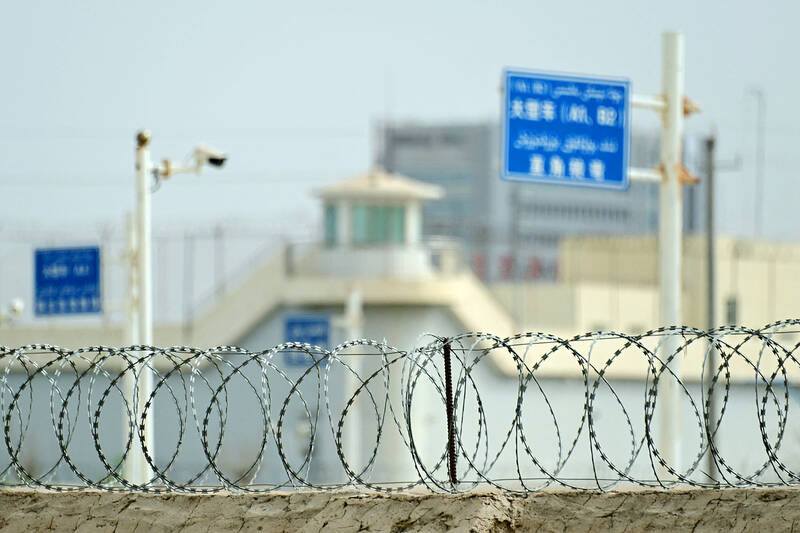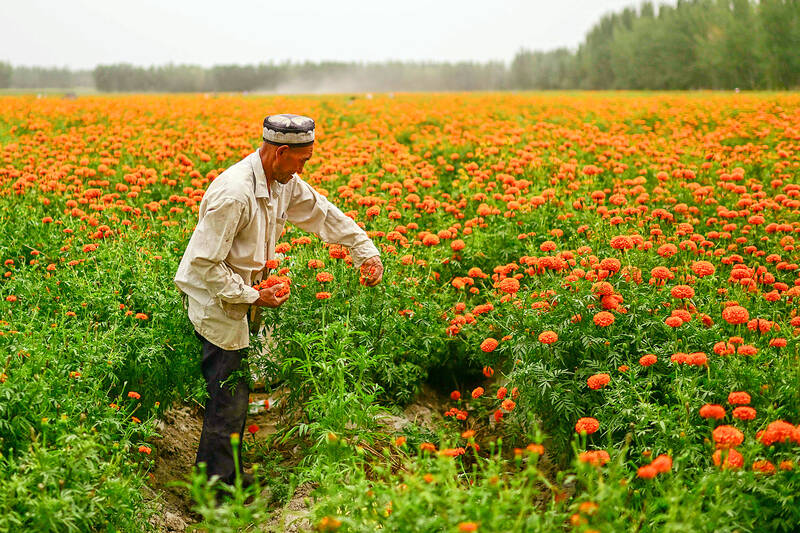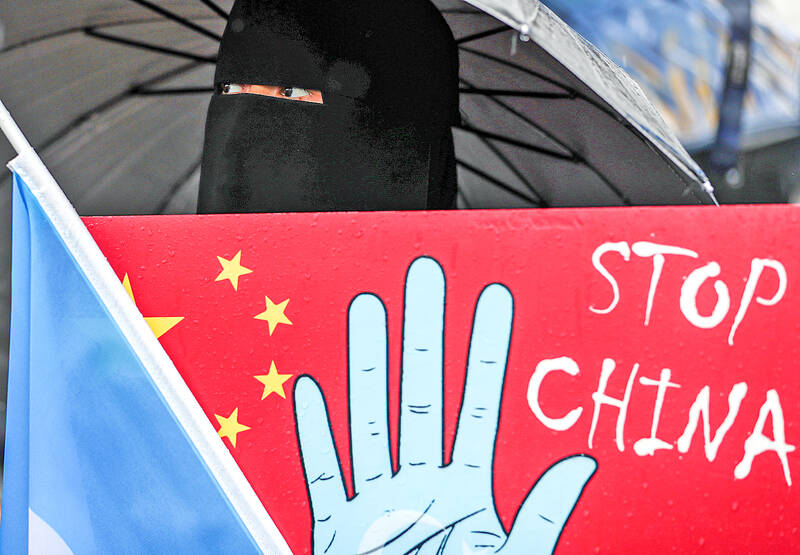Xinjiang is an area that has become associated around the world with detention camps. The facilities are referred to by Beijing as vocational education and training centers. But critics say they are used to indoctrinate Uyghurs and other minority ethnic groups with the goal of transforming them into devotees of the Chinese Communist party.
After unrest in the region and a series of riots and violent attacks by Uyghur separatists between 2014 to 2017, the Chinese leader, Xi Jinping (習近平), launched his Strike Hard Campaign Against Violent Terrorism, leading to the establishment of the camps. The UN has estimated that since then about one million people have been detained in these extrajudicial centers.
People who have spent time in the camps have reported a litany of abuses, including beatings and sexual violence. According to their testimonies, several of the centers also have forced labor facilities in the form of factories.

Photo: AFP
But forced labor in Xinjiang takes many forms, say experts, and is not just confined to the “re-education centers.” Prisoners are co-opted into labor — a feature of the criminal justice system across China. In 2019, a six-year-old girl in south London found a message that was apparently from a prisoner in Shanghai in a box of Tesco Christmas cards. In Xinjiang, the majority of prison labor happens in the agricultural sector, including cotton planting, harvesting and ginning, according to evidence submitted by Laura Murphy and Nyrola Elima, researchers at Sheffield Hallam University, to the UN.
The risk uncovered by the Guardian and Follow the Money in relation to the Bachu biomass facility concerns a third type of forced labor, which is not as widely understood in the west: state-sponsored labor transfers.
Beijing describes these transfers as a poverty alleviation tool and they predate the Strike Hard campaign. The programs work by identifying unemployed people in rural areas and transferring them to farms or factories in different locations where there is a need for workers. This happens within Xinjiang and from Xinjiang to other parts of China.

Photo: AFP
According to research by Murphy and Elima, in impoverished areas at least one person per household is expected to participate in a labor transfer program. The Xinjiang regional government says that about 2.6 million people have been employed through these initiatives. Many of these programs, particularly in southern Xinjiang, are linked to the cotton industry. More than 80 percent of China’s cotton comes from Xinjiang.
In 2020, the Chinese government published a white paper defending many of these policies. Between 2018 and 2019, 155,000 people from poor households and farms “found employment outside of their hometowns and subsequently emerged from poverty,” said the government. The white paper also said that between 2014 and 2019, the average annual disposable income for rural residents increased from 8,724 yuan (US$1,196) to 13,100 yuan (US$1,796).
However, last year, the UN rapporteur on slavery said that “indicators of forced labor” were present in “many” of China’s poverty alleviation programs in Xinjiang.

Photo: EPA-EFE
The labor transfer program has links to the more recent Strike Hard campaign. According to a 2017 government document about how to identify religious extremism in Xinjiang, refusal of government subsidies or assistance is a red flag. Being identified as a potential extremist is grounds to be sent to an internment camp. Uyghurs who have left Xinjiang and academics who study the region say that these programs are not voluntary.
According to a report published by the UN’s human rights chief last year, “the close link between the labor schemes and the counter-‘extremism’ framework, including the VETC [Vocational Education and Training Centre] system, raises concerns in terms of the extent to which such programs can be considered fully voluntary.” The Chinese government said the UN’s report was based on “disinformation and lies fabricated by anti-China forces.”
The Chinese government says the re-education centers were closed in 2019 and most of the students have graduated into stable employment. Journalists who have visited the region have found that many of the facilities appeared to be closed, but there are concerns the detainees have been transferred into the formal prison system rather than being released. In 2018, the number of criminal cases in Xinjiang increased by 25 percent compared with the previous five years; in 2019 the increase was just over 19 percent.

On April 26, The Lancet published a letter from two doctors at Taichung-based China Medical University Hospital (CMUH) warning that “Taiwan’s Health Care System is on the Brink of Collapse.” The authors said that “Years of policy inaction and mismanagement of resources have led to the National Health Insurance system operating under unsustainable conditions.” The pushback was immediate. Errors in the paper were quickly identified and publicized, to discredit the authors (the hospital apologized). CNA reported that CMUH said the letter described Taiwan in 2021 as having 62 nurses per 10,000 people, when the correct number was 78 nurses per 10,000

As we live longer, our risk of cognitive impairment is increasing. How can we delay the onset of symptoms? Do we have to give up every indulgence or can small changes make a difference? We asked neurologists for tips on how to keep our brains healthy for life. TAKE CARE OF YOUR HEALTH “All of the sensible things that apply to bodily health apply to brain health,” says Suzanne O’Sullivan, a consultant in neurology at the National Hospital for Neurology and Neurosurgery in London, and the author of The Age of Diagnosis. “When you’re 20, you can get away with absolute

May 5 to May 11 What started out as friction between Taiwanese students at Taichung First High School and a Japanese head cook escalated dramatically over the first two weeks of May 1927. It began on April 30 when the cook’s wife knew that lotus starch used in that night’s dinner had rat feces in it, but failed to inform staff until the meal was already prepared. The students believed that her silence was intentional, and filed a complaint. The school’s Japanese administrators sided with the cook’s family, dismissing the students as troublemakers and clamping down on their freedoms — with

As Donald Trump’s executive order in March led to the shuttering of Voice of America (VOA) — the global broadcaster whose roots date back to the fight against Nazi propaganda — he quickly attracted support from figures not used to aligning themselves with any US administration. Trump had ordered the US Agency for Global Media, the federal agency that funds VOA and other groups promoting independent journalism overseas, to be “eliminated to the maximum extent consistent with applicable law.” The decision suddenly halted programming in 49 languages to more than 425 million people. In Moscow, Margarita Simonyan, the hardline editor-in-chief of the